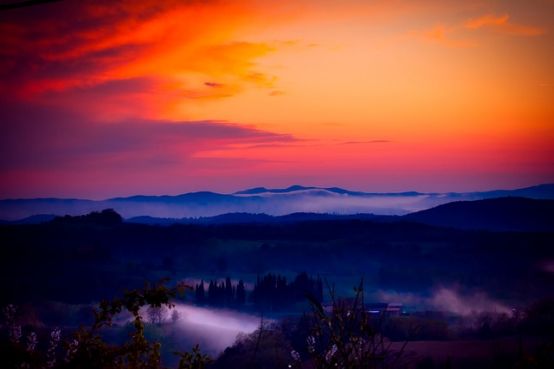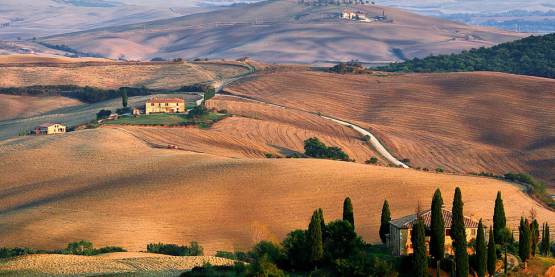Although Italy possesses less agricultural land than France, it actually produces and exports more wine than any other country in the world. It's reputation as a wine producer is continually gaining more importance also due to the fact that its wine growers offer the greatest variety of wines, ranging through nearly every conceivable colour, flavour and style imaginable. The tradition of wine-making was first established in Italy more than 4,000 years ago, so its not surprising that modern-day Italians produce some of the best wines in the world.
The country of Italy is made up of twenty separate regions or states. In turn, the country can be further divided into four sections for the purpose of discussing its wine production; North-east Italy, North-central and North-west regions, Central Regions, and finally the South and Islands.
The North-east leads Italy in the technology of winemaking, where the methods of wine making are more sophisticated and better organized than in other parts of Italy. This is particularly related to the continual demands of consumers from the nearby countries of Germany, Austria and Switzerland. You can experience the great depth of wine production in North-east Italy on our wine tours of the Friuli wine region.
The regions of Veneto, Friuli and Trentino-Alto Adige are the three principal areas of production. This area produces more than a third of the countries DOC wines. But this production, in many cases is of a high quality produced by a boutique style wineries where quality outweighs quantity in the minds of the wine makers. In fact, the region produces less than a sixth of the total production of Italy.
The region boasts two of Italy 's most important wine schools at San Michele all'Adige in Trentino and at Conegliano in Veneto. While in Friuli, the Rauscedo vine nursery is the largest in the world.
Along with the nations most important wine fair, VINITALY, which is held in Verona every spring the North-east of Italy plays a leading role in the direction of the Italian wine industry. The determining factor that has enabled this area to produce such a varied list of wines is that all three regions are influenced climatically by the Alps, and throughout their many wine DOC regions there are numerous micro-climates.
Of the wines produced in the North-east of Italy, Verona's Soave, Valpolicella and Bardolino are the best known of the many DOCs. They derive almost entirely from native varieties. But in the central and eastern Veneto and Friuli imported varieties - such as Merlot, Cabernet, the Pinots, Chardonnay and Sauvignon - are vying successfully for vineyard space against the local Tocai, Prosecco, Verduzzo, Refosco and Raboso. In Trentino-Alto Adige red wines prevail, dominated by the ubiquitous Shiava or Vernatsch, though the more distinguished Teroldego, Lagrein and Marzemino hold their own against Cabernet, Merlot and Pinot Nero. Take our Valpolicella Wine Tours to appreciate the famous Amarone and other wines produced in the Valpolicella wine region which is located near Verona
The five regions of north-central and northwest Italy cover much of the great arc of the Alps and Apennines that walls in the Po as it flows east through its broad valley to the Adriatic. The types of wine - like the topography, soil and climate - vary to extremes in these regions, which are grouped rather loosely as neighbours but, in true Italian style, maintain their own proud identities. Between them, the five regions produce about 20% of Italy 's total wine and account for about 30% of the DOC.
Despite the proximity of France , whose vines have been warmly welcomed elsewhere in Italy, growers in Piedmont, Valle d'Aosta and Liguria prefer their own vines and tend to make wine in their own style. Piedmont's host of worthy natives includes Barbera, Dolcetto, Grignolino, Freisa, Cortese, Arneis, Brachetto, the Canelli clone of Moscato (for Asti Spumante) and the noblest of them all in Nebbiolo (source of Barolo, Barbaresco and Gattinara).
The vines of Valle d'Aosta often have French names - Petit Rouge, Gros Vien, Blanc de Valdigne, for instance - due to the Savoyard history of the region. Liguria favours the local Rossese, and Vermentino, while working with its own version of Dolcetto, known as Ormeasco.
But lately growers have been concentrating on distinctive wines from the hills. Best known are the Alban and Sangiovese of Romagna, but gaining notice are Barbera, Cabernet, Chardonnay and Sauvignon from the Apennine foothills of Emilia.
In the past the Central region of Italy produced poor wine and its producers paid little attention to new developments in their industry. But, today the central region also produces fine wines, led by Tuscany with Chianti and other noble reds, are rapidly moving to the forefront of Italian enology.
Between them, the six regions produce less than a quarter of the nation's wine, yet they account for about a third of the DOLC or DOCG. The realm of Sangiovese is Florence 's region of Tuscany , where it prevails in Chianti - the nation's archetypical wine - as well as in Brunello di Montalcino, Vino Nobile di Montepulciano and most of the noteworthy classified and unclassified reds. White Malvasia reigns in Rome's region of Latium.
The Adriatic regions have a rather neat and straight-forward structure of vines and wines. Vineyards are almost all planted in hills running in a tortuous strip between the sea and the mountains, where the climate is tempered by cool currents. Two native varieties stand out along the Adriatic coast, the white Verdicchio in the Marches and red Montepulciano, which originated in the Abruzzi and is now widely planted in all three regions.
When the Greeks first settled in Italy, in the South they christened Italy the land of vines. They immediately realized the potential of these lands to produce fine wines. Unfortunately, in the past the Italians were slow to realize the potential of the south.
In fact, for many years the winemakers in the southern part of Italy concentrated on quantity rather than quality of their wines. But, in recent times with the influence of wine makers from the north buying land and cultivating vines in the south the wine industry in southern Italy has gone through a minor revolution. Sicily in particular is producing fine red wines for long ageing, and the primitive wines of Campagnia and Puglia are gaining in popularity each year.












